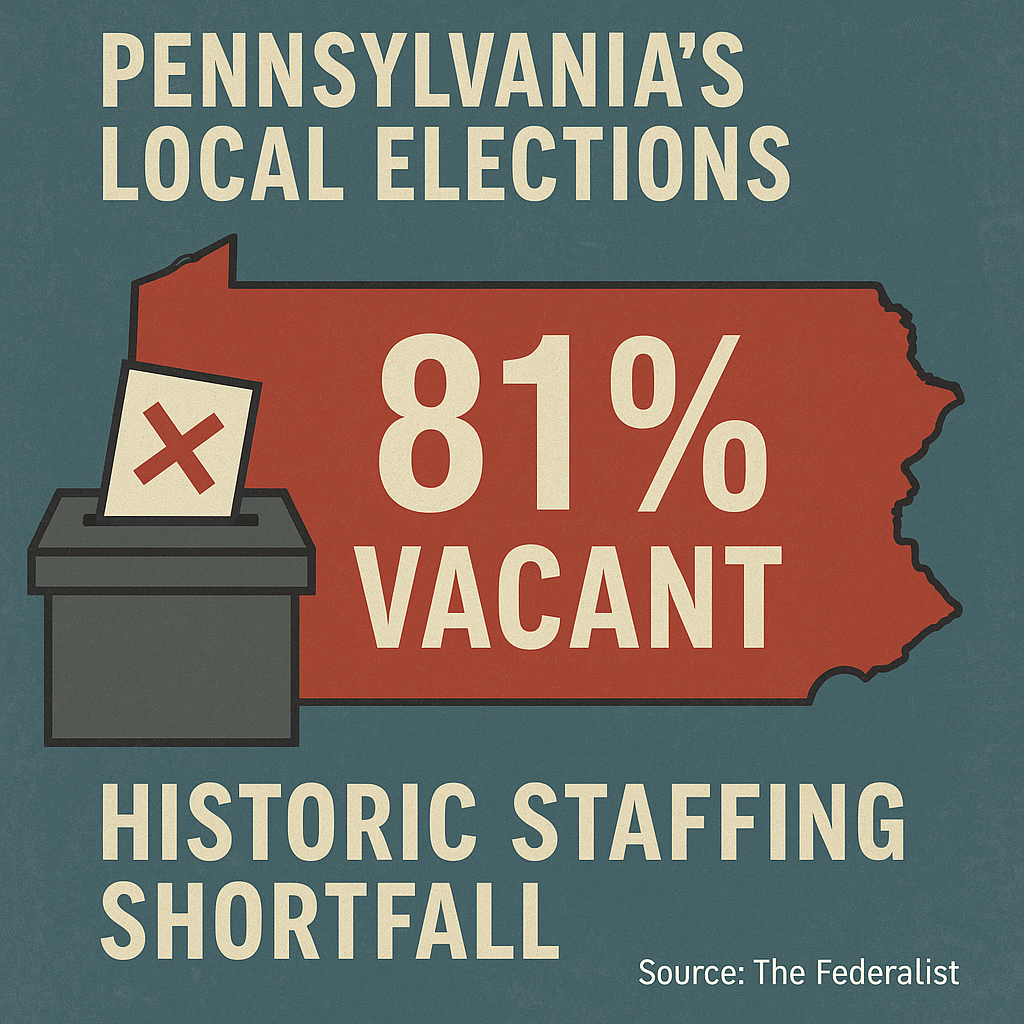A silent crisis in local governance threatens to undermine the 2026 and 2028 elections, starting with Pennsylvania’s alarming vacancy rate.
What to Know:
- 81% of Pennsylvania precincts have no candidates for Judge of Elections or inspector roles ahead of the May 2025 primary.
- Only 1,729 people filed for over 13,000 positions; 8,000 precincts are missing both inspectors.
- Allegheny County must appoint 1,153 judges; Philadelphia has just 46 Republican candidates across 1,709 precincts.
- Barriers include low pay, complex filing, and lack of public awareness about these critical roles.
- Experts warn this breakdown could spread to other states if left unaddressed.
In what may be one of the most underreported crises in American democracy, a new investigation by The Federalist reveals that over 81% of Pennsylvania’s precincts have no candidates running for key election administration roles ahead of the state’s May 20, 2025, primary. That means nearly 11,000 out of 13,000 precincts are flying blind without a judge of elections or election inspectors, the local officials tasked with running polling places and certifying vote totals.
Pennsylvania is the only state in the country where voters elect these local election officials. The system, however, starts to falter when voters choose to stay at home or not run at all. And in a swing state that played a pivotal role in both the 2020 and 2024 presidential contests, this collapse in civic participation could have national consequences.
Why These Officials Are Important and Who Are They?
The Judge of Elections is the top election official in each precinct. They’re responsible for managing the polling place, resolving disputes, ensuring accessibility compliance, and signing off on results at the end of the day. Supporting them are two inspectors—one from each party—who verify voter eligibility and help maintain the voting log.
Data source: The Federalist
Despite the importance of these roles, just 1,729 candidates filed to run for Judge of Elections statewide. That leaves more than 9,000 precincts without anyone on the ballot for the role. And the outlook for inspector positions is even worse: 8,000 precincts are lacking both a majority and minority inspector candidate, meaning three-person boards could be reduced to zero unless counties scramble to appoint replacements.
Here’s a clear visual breakdown of Pennsylvania’s local election staffing crisis. Source: The Federalist
County-by-County Breakdown: Alarming Gaps
The crisis is not evenly distributed. In Allegheny County (home to Pittsburgh), there are 1,328 precincts but just 175 candidates for Judge of Elections. That forces county commissioners to appoint the remaining 1,153 officials—a logistical nightmare and a potential political flashpoint.
Appointment crisis in Allegheny, party gap in Philly. Source: The Federalist
In Philadelphia, the disparity is compounded by party imbalance. The city has 1,709 precincts, yet only 716 candidates filed to run. Of those, a mere 46 are Republicans, raising concerns about partisan representation in precinct-level election boards.
Why It Matters for 2026—and Beyond
Without candidates, Pennsylvania’s counties will need to appoint thousands of election workers, many of whom will serve through the 2026 midterms and potentially the 2028 presidential election. These appointments aren’t minor: they will be responsible for counting ballots in what are likely to be razor-thin contests in a deeply divided political climate.
Appointed officials may lack the legitimacy or transparency that comes from electoral selection, and critics worry this could open the door to claims of partisanship or incompetence. Worse still, these roles often go untrained or unfilled, raising real questions about election preparedness.
How Did We Get Here?
Burnout among volunteers is not the only problem here. Multiple structural and cultural factors are to blame:
- Lack of Awareness: Many Pennsylvanians don’t know these positions exist—or that they’re elected.
- No Incentive: These are low-paid, low-prestige roles that require long hours on Election Day.
- Complex Filing Process: Running requires signatures, paperwork, and sometimes notary services—barriers that deter casual civic engagement.
- Party Apathy: In heavily one-party areas, the opposing party often doesn’t bother recruiting candidates, leading to one-sided control or empty boards.
What Happens if This Spreads?
The real concern isn’t limited to Pennsylvania. If civic disengagement at this level is happening in a key battleground, other states could follow suit. Local elections from Michigan to Arizona rely on the frequently unseen infrastructure of inspectors, judges, and poll workers. Without them, democracy collapses, silently and disastrously.
What Can Be Done?
To reverse the collapse in local election participation, experts and election officials are calling for urgent reforms that restore civic engagement at the grassroots level. County and state agencies must begin with sustained public awareness campaigns to educate voters on the existence and importance of precinct-level election roles. Far too many residents are unaware that these positions even exist, let alone that they are elected.
At the same time, the process of becoming a candidate must be simplified. The current system, burdened with paperwork, signature thresholds, and bureaucratic hurdles, discourages otherwise willing participants. Making it easier to file could significantly broaden the applicant pool.
Equally pressing is the need to address compensation. Serving as a judge or inspector of elections often comes with pay so low it doesn’t cover basic costs like transportation and meals. Raising wages, even modestly, could help attract more applicants who would otherwise opt out due to financial strain.
Perhaps most crucially, political parties must begin treating these positions as foundational infrastructure, not afterthoughts. A renewed focus on bipartisan recruitment could help ensure precinct boards are not only fully staffed but also representative and balanced. These roles aren’t ceremonial—they are the front lines of American democracy, and they must be filled with intention.
Wrap Up
The shortage of candidates for local election roles in Pennsylvania represents a serious structural issue, not just for the state but potentially for the nation. Without judges of elections and inspectors in place, counties must rely on appointments to fill thousands of vacancies—an unsustainable solution that raises concerns about consistency, transparency, and preparedness heading into major election cycles.
These roles are essential for running elections smoothly and lawfully. If they remain vacant, the risk isn't just administrative delay but a loss of basic electoral function. Pennsylvania’s case shows what happens when civic infrastructure is neglected. Rebuilding it will require clear communication, streamlined processes, and renewed engagement from the public. Otherwise, the core mechanisms of election day—verification, tabulation, and oversight—face mounting strain at a time when trust in elections remains a critical issue.
As The Federalist aptly reports,
"No other state asks voters to fill these roles—and now it’s clear that voters, when left to their own devices, won’t."
Without a concerted effort to address these gaps, the most vital infrastructure in American elections—local human infrastructure—will continue to erode. And when it finally fails, the breakdown won’t be loud. It’ll be silent. Just like the ballots that never get counted.
Read the original report in The Federalist for the full data and breakdown.


